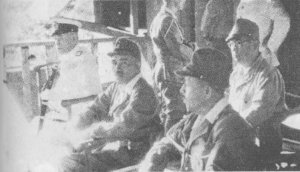![]() The Pacific War Online Encyclopedia
The Pacific War Online Encyclopedia
|
| Previous: I-12, Japanese Submarine | Table of Contents | Next: Iakutsk |

Agawa (1979). Via Wikimedia Commons
I-Go (or "I" Operation) was an air offensive conducted by Yamamoto in the South Pacific in April and May 1943. The objective of I-Go was to disrupt the Allied buildup in New Guinea and the Solomon Islands to buy time to build up the defenses of the Bismarcks.
Following the Japanese defeat at Guadalcanal, Imperial General Headquarters reconsidered the Japanese strategic
position, and on 15 March 1943 issued
the "Joing Army-Navy Central Agreement on Southeast Area Operations."
This called for the establishment of "a superiorand impregnable
strategic position" (quoted in Gamble 2010) and implicitly acknowledged
the end of the Second Operational Phase
in favor of a defensive strategy. The only offensive action called for
in the document was a limited aerial counterattack against the Solomon Islands. The Imperial Navy air forces were to engage in "aerial
supremacy combat, interception of enemy transportation, interception of
enemy aircraft, ground support, and covering lines of communications
and supplies" (Gamble 2010).
The decision
to carry out I-Go was made by
25 March 1943. Both Guadalcanal and Papua New Guinea were designated as target areas. Yamamoto's force consisted of 86 fighters,
27 dive bombers, 72 medium bombers, and a handful
of torpedo bombers from 11 Air Fleet. These were
supplemented with 96 fighters, 65 dive bombers, and a few torpedo
planes stripped from carriers
Zuikaku,
Zuiho,
Junyo,
and Hiyo. These were based at Rabaul and its outlying fields at Buka, Kahili
and Ballale.
The first phase of I-Go began on 1 April 1943 with a preliminary fighter sweep against Guadalcanal. Allied intelligence had detected the buildup of aircraft and the fighter sweep by 58 A6M Zeros was intercepted near the Russell Islands by 42 American fighters, mostly F4F Wildcats with a handful each of P-38 Lightnings and F4U Corsairs. The Japanese claimed to have shot down 47 American fighters, more than the number actually engaged, while the Americans claimed 18 Zeros. Actual losses were nine Zeros and six American aircraft, with three of the American pilots recovered. On 7 April 1943 the Japanese launched "Attack X", an enormous raid by 67 D3A Vals escorted by 110 Zeros that was opposed by 76 Allied fighters: 36 F4F Wildcats, 9 F4U Corsairs, 6 P-40 Warhawks, 12 P-38 Lightnings and 13 P-39 Airacobras. At 1400 Guadalcanal broadcast "Condition Red" followed shortly thereafter by an unprecedented and highly irregular "Condition Very Red." The Japanese claimed 41 American aircraft shot down and the American claimed 26 Zeroes and 13 Vals. Actual losses were 12 Zeroes and 9 Vals for the Japanese and 7 Wildcats for the Americans, with all the American plots recovered. A number of Vals leaked through the Allied defenses, and the Japanese pilots claimed twelve ships sunk and two heavily damaged. Actual Allied shipping losses were a destroyer, a corvette, and a tanker.
On 11 April 1943 the second phase of I-Go, the attack on New Guinea,
began. "Attack Operation Y" opened at 1220 with some 22 Vals and 72 Zeros attacking shipping at Oro Bay,
near Buna. They were met by fifty
Allied fighters from Dobodura that shot down six Japanese aircraft
without loss. However, a cargo ship
was sunk, another crippled, and a minesweeper
damaged.
On 12 April 1943 the Japanese mounted the largest air raid yet on
Port Moresby. A force of 131 fighters and 43 medium bombers struck
Port Moresby. These were
opposed by 44 Allied fighters that were briefly diverted by a feint towards Milne Bay, which was assisted by glitches in the Allied radar
coverage. As a result, the Japanese
bombers were able to slip through. However, the Japanese failed to
concentrate their attacks on the best targets, and succeeded only in
damaging a few small craft and
destroying four aircraft on the airfields. Ten
Japanese aircraft were lost, either shot down or crashing on attempting
to land back at their bases.
On 14 April 1943 the Japanese struck Milne Bay with 188 aircraft. This was opposed by just 24 Kittyhawks and the Japanese sank a cargo ship and damaged another. Eight Japanese aircraft were lost for three Allied aircraft.
The operation was ordered halted on 16 April 1943 when Yamamoto ordered the carrier air groups back to their carriers. Japanese claims were greatly exaggerated: a cruiser, two destroyers, and 25 transports and 175 aircraft shot down. Actual Allied losses were a destroyer, a tanker, a corvette, two cargo ships, and 25 aircraft. Though believing the operation a great success, the Japanese were beginning to be alarmed by their own losses: 26 percent of the Vals and 18 percent of the Bettys had already been expended. Yamamoto's decision to employ carrier air groups from land bases has been heavily criticized as a waste of the highly trained aircrew, whose carrier landing skills were irreplaceable. The actual results achieved hardly justified the diversion of so many resources.
The exaggerated claims of success prompted Yamamoto to visit the forward air bases to personally congratulate the air crew. However, Yamamoto's itinerary was broadcast in a code the Allies were able to penetrate, and his aircraft was intercepted and shot down on 18 April 1943. None of the passengers and crew of Yamamoto's aircraft survived.
The "Big Raid". Another series of raids began on 7 June 1943.
On that day and on 12 June, Japanese aircraft raided Guadalcanal but
again failed to achieve decisive results. On 16 June came a much larger
raid by over 100 aircraft. Two Allied ships were forced to beach and
six Allied fighters were shot down, but the Allies claimed 98 Japanese
aircraft destroyed, and the Japanese admitted the loss of about 30
aircraft.
References
The Pacific War Online Encyclopedia © 2008, 2013 by Kent G. Budge. Index